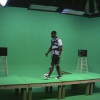Free Online Productivity Tools
i2Speak
i2Symbol
i2OCR
iTex2Img
iWeb2Print
iWeb2Shot
i2Type
iPdf2Split
iPdf2Merge
i2Bopomofo
i2Arabic
i2Style
i2Image
i2PDF
iLatex2Rtf
Sci2ools
96
Voted
CVPR
2001
IEEE
2001
IEEE
Gait Recognition from Time-Normalized Joint-Angle Trajectories in the Walking Plane
This paper demonstrates gait recognition using only the trajectories of lower body joint angles projected into the walking plane. For this work, we begin with the position of 3D markers as projected into the sagittal or walking plane. We show a simple method for estimating the planar offsets between the markers and the underlying skeleton and joints; given these offsets we compute the joint angle trajectories. To compensate for systematic temporal variations from one instance to the next -- predominantly distance and speed of walk -- we fix the number of footsteps and timenormalize the trajectories by a variance compensated time warping. We perform recognition on two walking databases of 18 people (over 150 walk instances) using simple nearest neighbor algorithm with Euclidean distance as a measurement criteria. We also use the expected confusion metric as a means to estimate how well joint-angle signals will perform in a larger population.
Body Joint Angles | Computer Vision | CVPR 2001 | Joint Angle Trajectories | Simple Nearest Neighbor | Systematic Temporal Variations | Variance Compensated Time |
| Added | 12 Oct 2009 |
| Updated | 29 Oct 2009 |
| Type | Conference |
| Year | 2001 |
| Where | CVPR |
| Authors | Rawesak Tanawongsuwan, Aaron F. Bobick |
Comments (0)

